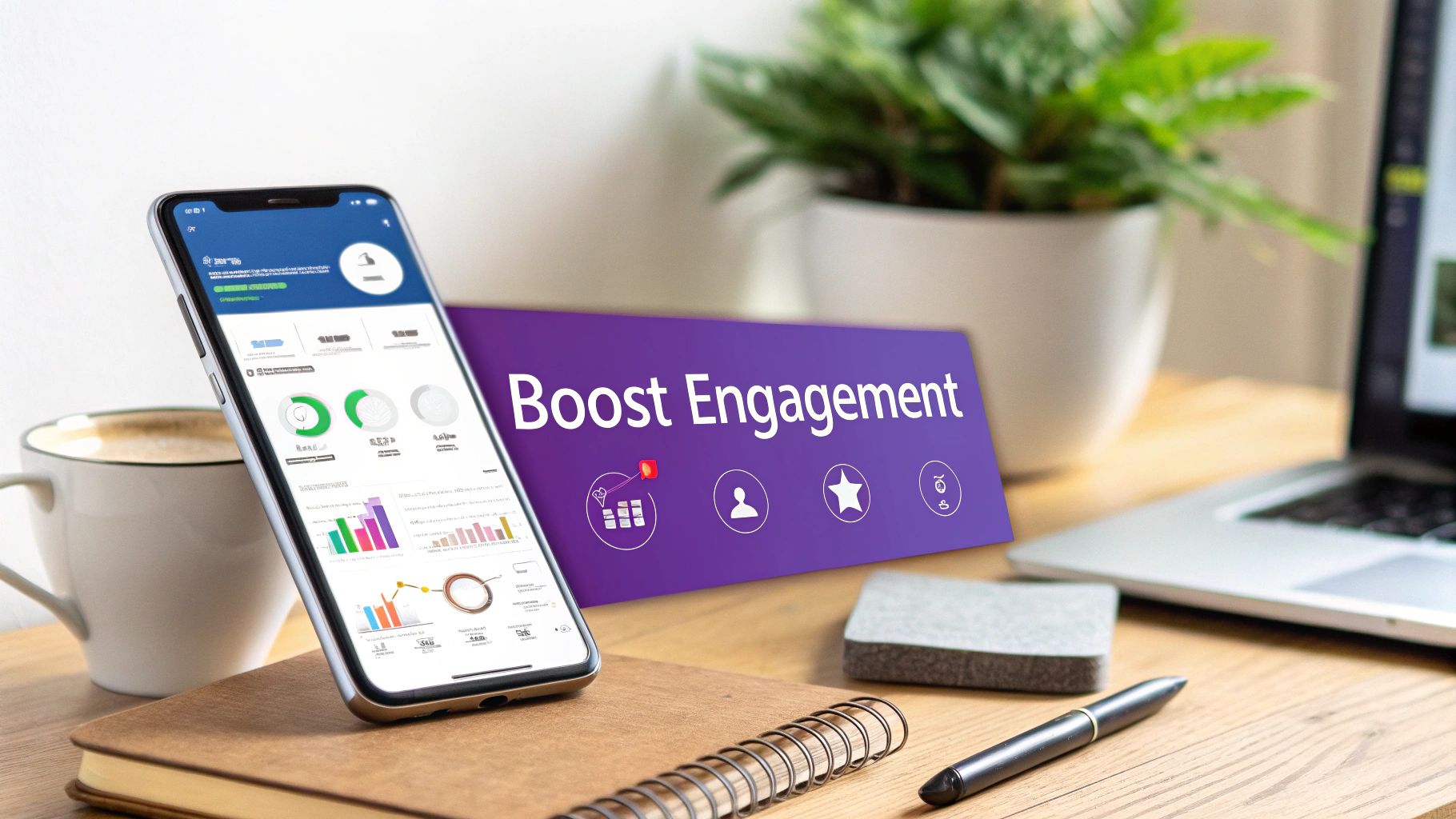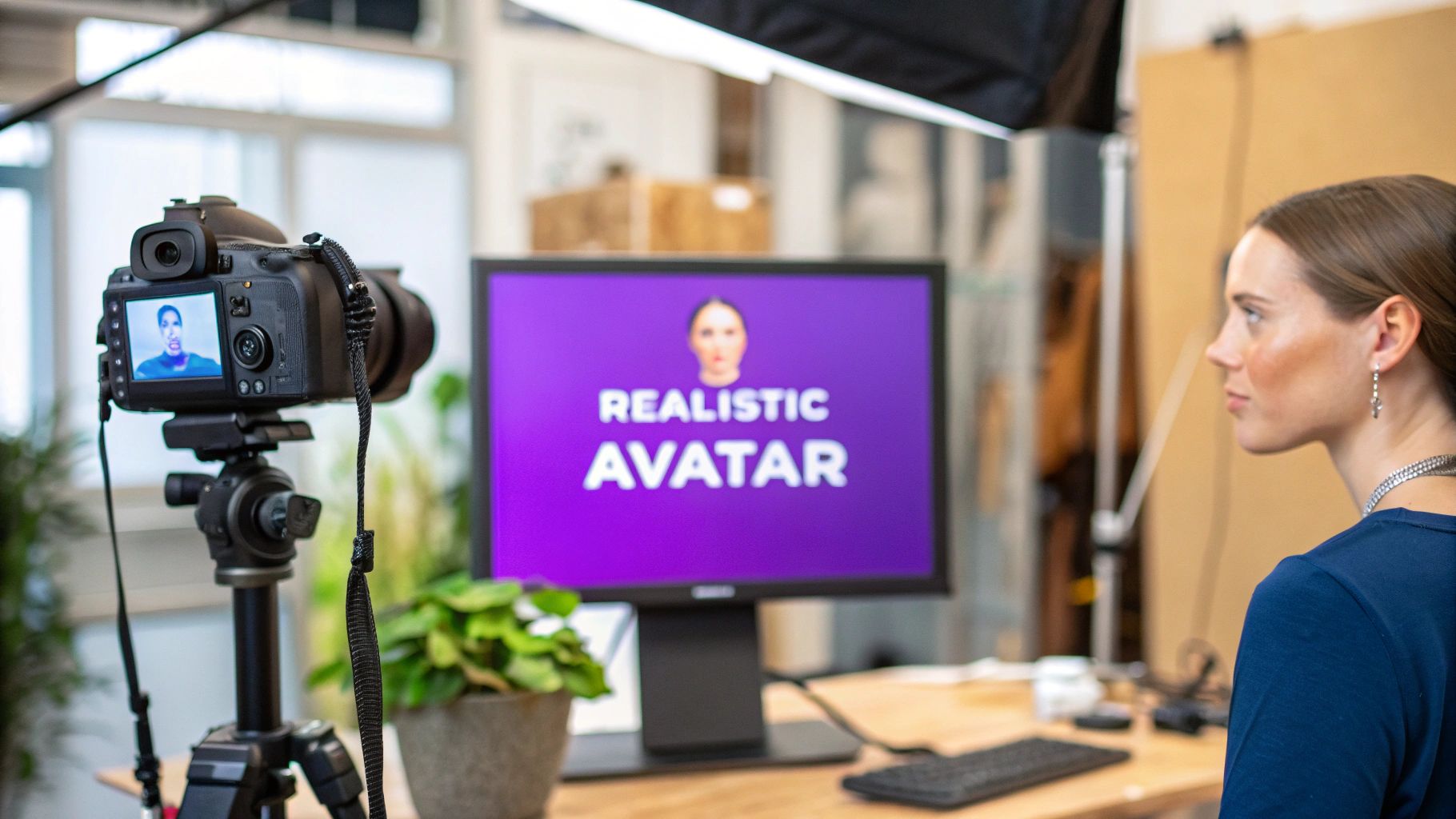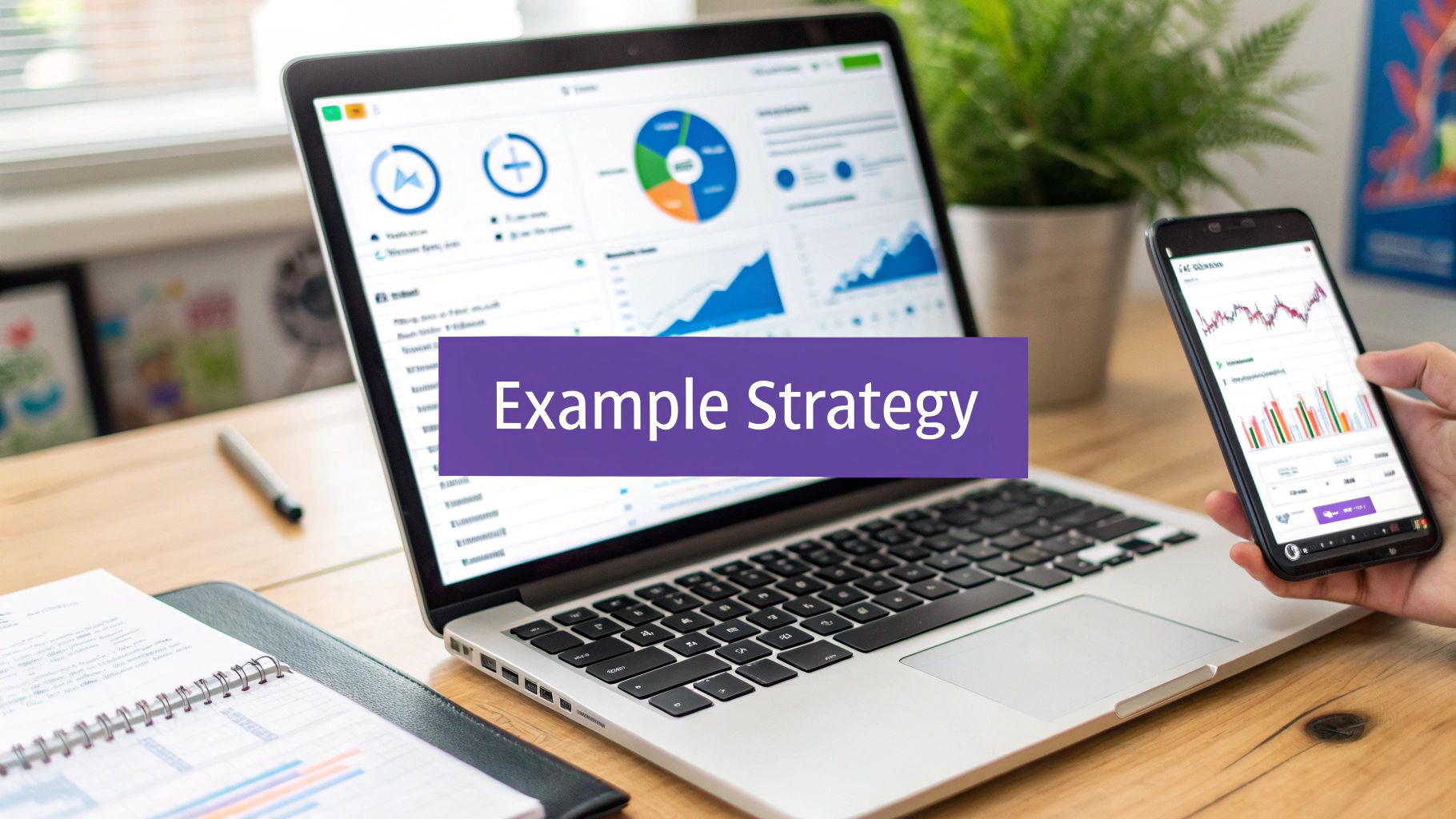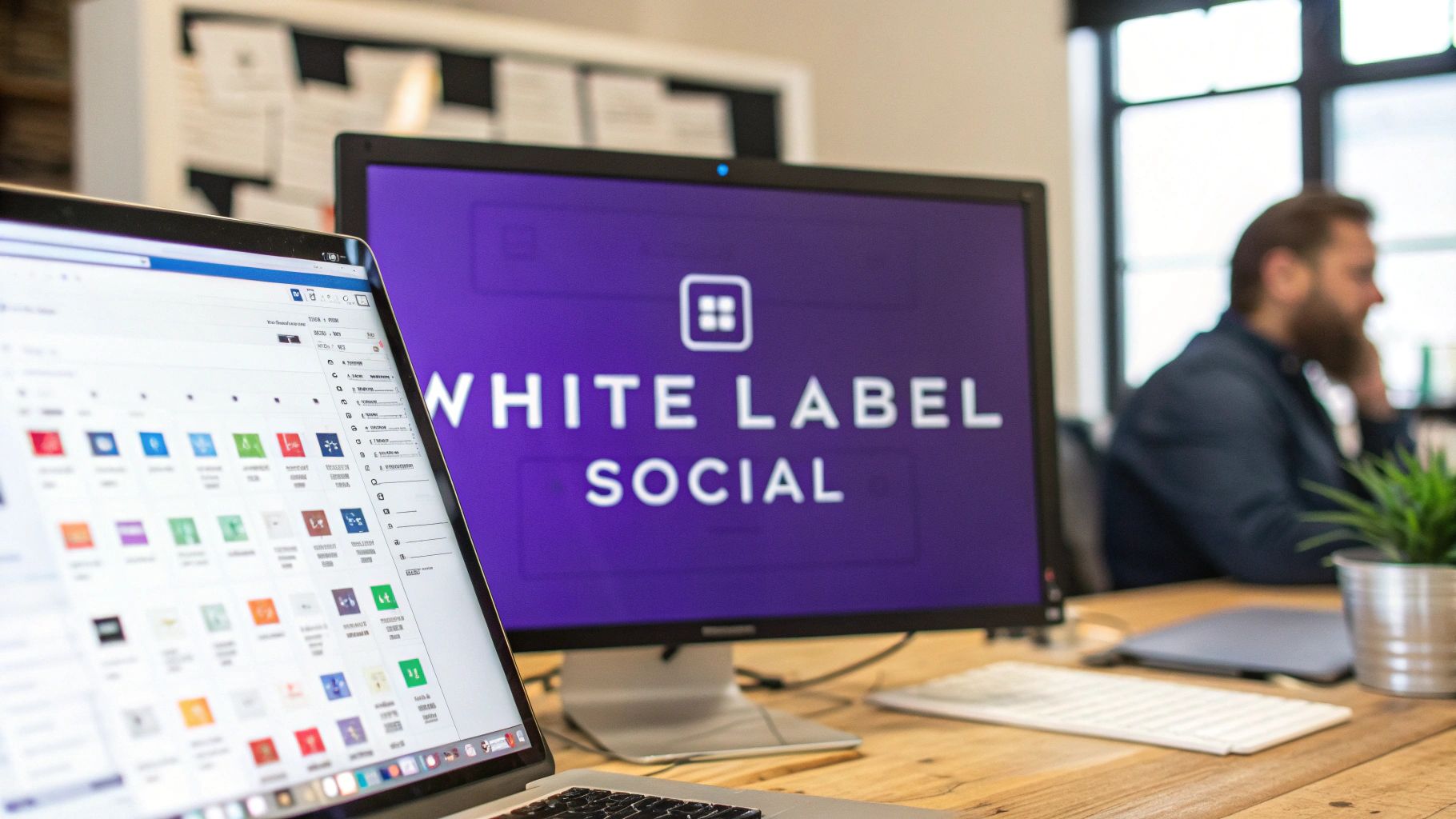Master Automated Social Media Posting
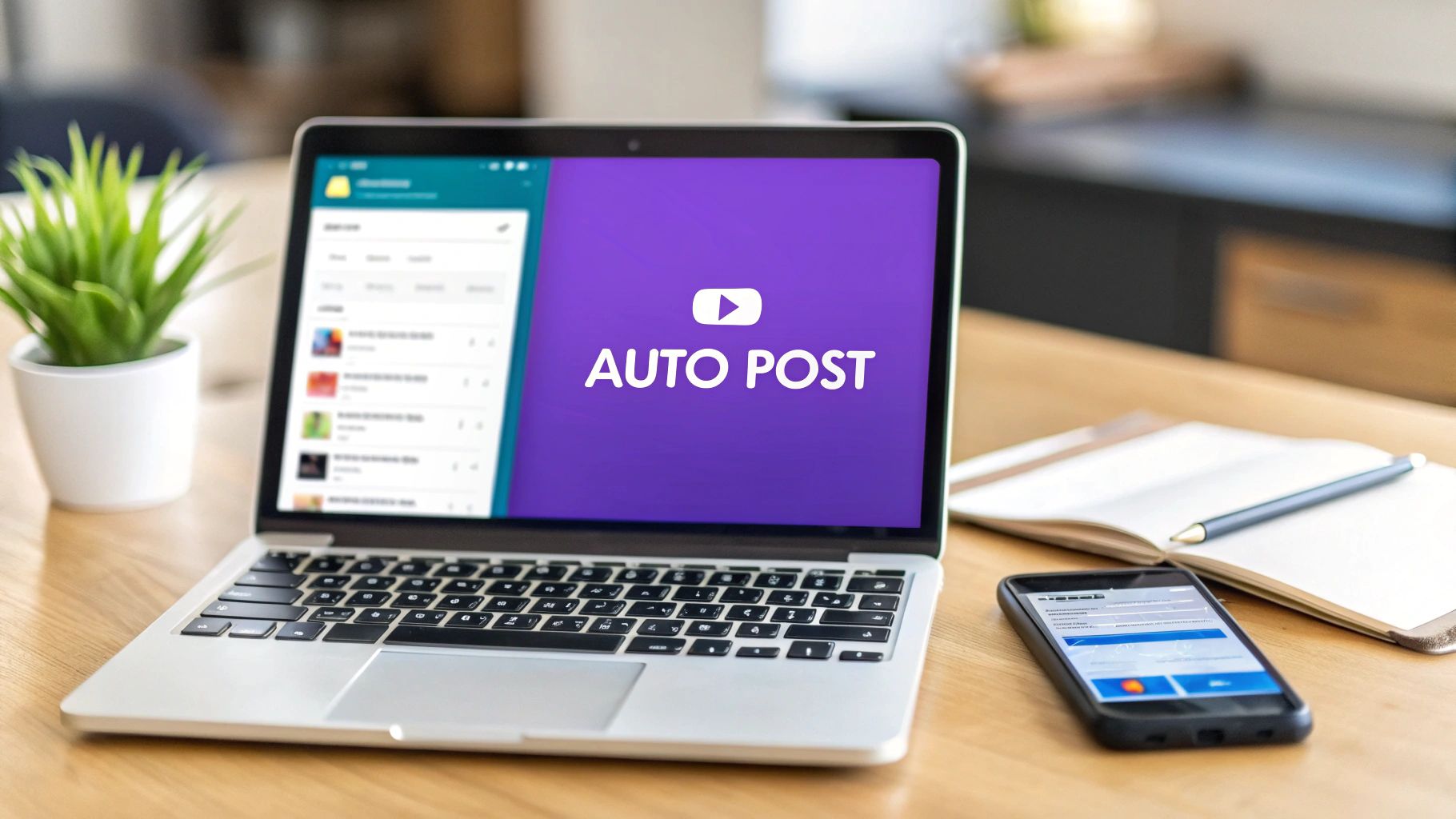
Let's be real: manually posting to every single social media account is a one-way ticket to burnout. Juggling multiple platforms, trying to tailor content for each one, and hitting those "optimal" posting times feels like a full-time job on its own. It's a constant content treadmill that often leads to rushed, uninspired posts and zero time for genuine connection.
The truth is, automated social media posting isn't some fancy luxury anymore. It's a foundational piece of any smart marketing plan, changing the game for brands that want to stay consistent and keep their audiences hooked.
Moving Beyond Manual Social Media Management
When you're buried in the day-to-day grind of posting, you have no time left for the stuff that actually drives growth—analyzing what works, talking to your community, and refining your strategy.
This is where automation comes in, not just as a time-saver, but as a strategic partner. It’s about building a system that works for you, keeping your brand visible and active even when you’re focused on other parts of the business. By scheduling content in advance, you create the consistency that builds trust and keeps your audience coming back.
By taking repetitive tasks off your plate, automation frees up valuable mental energy. This allows you to shift from a reactive content creator to a proactive strategist, focusing on high-impact activities that nurture your community and achieve business goals.
The Scale of Modern Social Media
The numbers alone make a pretty clear case for automation. As of 2025, there are roughly 5.45 billion social media users around the world. These users spend an average of 2 hours and 24 minutes a day scrolling through about seven different platforms.
Trying to reach even a tiny slice of that audience without the right tools is a losing battle. This is precisely why having an efficient way to get your content out there is so critical.
From Burnout to Strategic Advantage
Switching to an automated system completely changes how you approach social media. Suddenly, you can plan out content themes weeks or even months ahead, ensuring your brand message is cohesive and purposeful. It also gives the platform algorithms the consistency they love, which can boost your organic reach.
For anyone ready to get serious, building this out with a solid small business social media strategy is the perfect next move.
Here's a high-level look at how the two approaches stack up.
Manual vs Automated Social Media Posting at a Glance
| Aspect | Manual Posting | Automated Posting |
|---|---|---|
| Effort | High daily time commitment | Low daily time commitment |
| Consistency | Often inconsistent, prone to gaps | Consistently active presence |
| Scalability | Difficult to scale across platforms | Easy to manage multiple accounts |
| Strategic Focus | Reactive, focused on daily tasks | Proactive, focused on growth |
The difference is night and day. Automation lets you reclaim your time so you can focus on the big picture.
The infographic below really drives home the tangible benefits of making this switch.
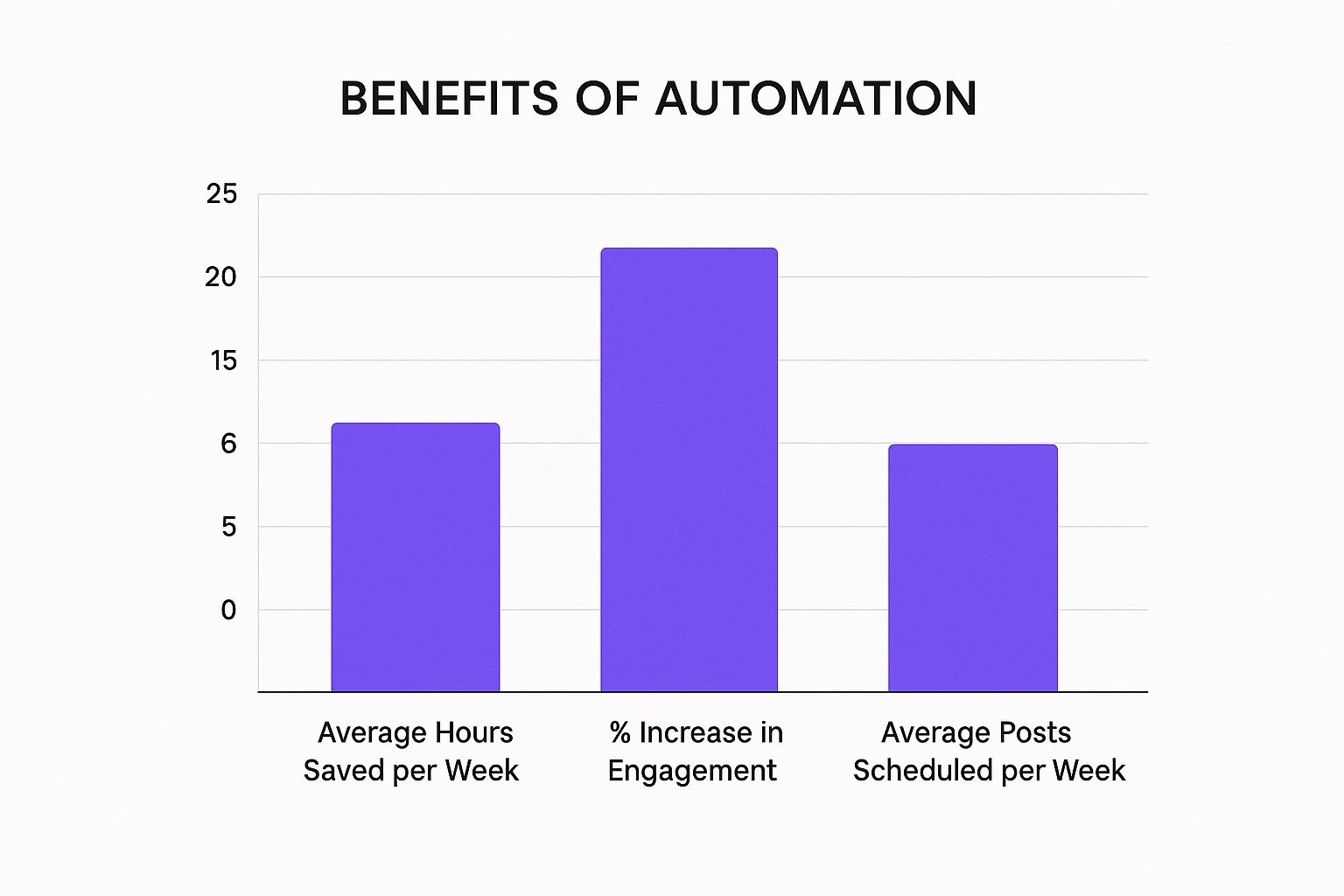
As the data shows, brands that automate save a significant amount of time each week. That time can be directly reinvested into strategic work, leading to better engagement and real results. There are tons of great resources out there to help you boost your business with Automated Social Media Posting and get your marketing machine humming.
Choosing Your Social Media Automation Toolkit

Alright, let's talk tools. Picking the right platform for automated social media posting is the first real hurdle you'll face, and it's a big one. The market is absolutely flooded with options, from dead-simple schedulers to massive, complex suites built for enterprise teams. The trick is to tune out the noise and zero in on what your brand actually needs to get the job done.
Your choice should be a direct reflection of your goals, how big your team is, and what your budget looks like. A solo entrepreneur has completely different needs than a marketing agency juggling a dozen clients. Don't get distracted by the shiniest new tool with a million features; find the one that solves your specific headaches.
Core Functionality to Evaluate
Before you even think about pulling out a credit card, you need to kick the tires and see how a tool handles the basics. Can you easily schedule posts across all your important networks from one clean dashboard? Is the content calendar something you can actually see yourself using every day, or is it a confusing mess?
Beyond the simple act of scheduling, here are the non-negotiables:
- Supported Platforms: Does the tool connect with every network that matters to your audience? I’m not just talking about the big ones like LinkedIn and X (formerly Twitter). If your audience lives on a niche platform, your tool needs to be there, too.
- Ease of Use: A clunky, frustrating interface will torpedo your productivity. The right tool should feel intuitive from the get-go, letting you schedule content, check your numbers, and manage your workflow without needing a user manual the size of a phone book.
- Collaboration Features: If you're working with a team or clients, features like post-approval workflows, different user permissions, and shared media libraries are essential. They're what keep your brand consistent and your communication streamlined.
A classic mistake is picking a tool just because it’s cheap. Sure, budget matters. But a cheap tool that wastes your time with a terrible user experience or constant glitches will end up costing you a lot more in lost productivity and sanity.
Advanced Features and Integrations
Once you’ve confirmed the fundamentals are solid, you can start looking at the bells and whistles that give you a real strategic advantage. This is where a basic scheduler becomes a true automation partner—something that helps you work smarter, not just faster.
A great example is the quality of the analytics. A good platform goes way beyond vanity metrics. It should offer deep insights into post performance, audience engagement, and the best times to post based on your own data, not some generic industry average. That data is what turns automated social media posting from a simple task into a powerful strategy.
Also, take a hard look at how the tool plays with your other software. Does it integrate with things like Canva, Google Drive, or your CRM? These connections can eliminate a ton of friction. For instance, being able to pull a finished graphic directly from a shared Canva folder into your scheduler saves time and cuts down on manual downloads and uploads.
Making the Final Decision
The best way to cut through the marketing fluff is to create a simple checklist comparing your top contenders. This forces an objective, side-by-side comparison based on what truly matters to your day-to-day workflow.
Here are a few final points to weigh:
- Analytics and Reporting: Can you build custom, shareable reports that track the specific metrics tied to your business goals?
- AI Capabilities: Does the tool offer any AI-powered help for writing captions, generating hashtags, or brainstorming post ideas?
- Customer Support: What kind of help is available when things go wrong? Fast, knowledgeable support is priceless when you're on a deadline.
- Scalability: Can this tool grow with you? Check out the higher-tier plans to make sure it can handle more accounts and users as your business expands.
By focusing on these practical criteria, you can confidently pick a toolkit that doesn’t just lighten your workload but actively helps you grow your social media presence.
Designing Your Automated Content Workflow
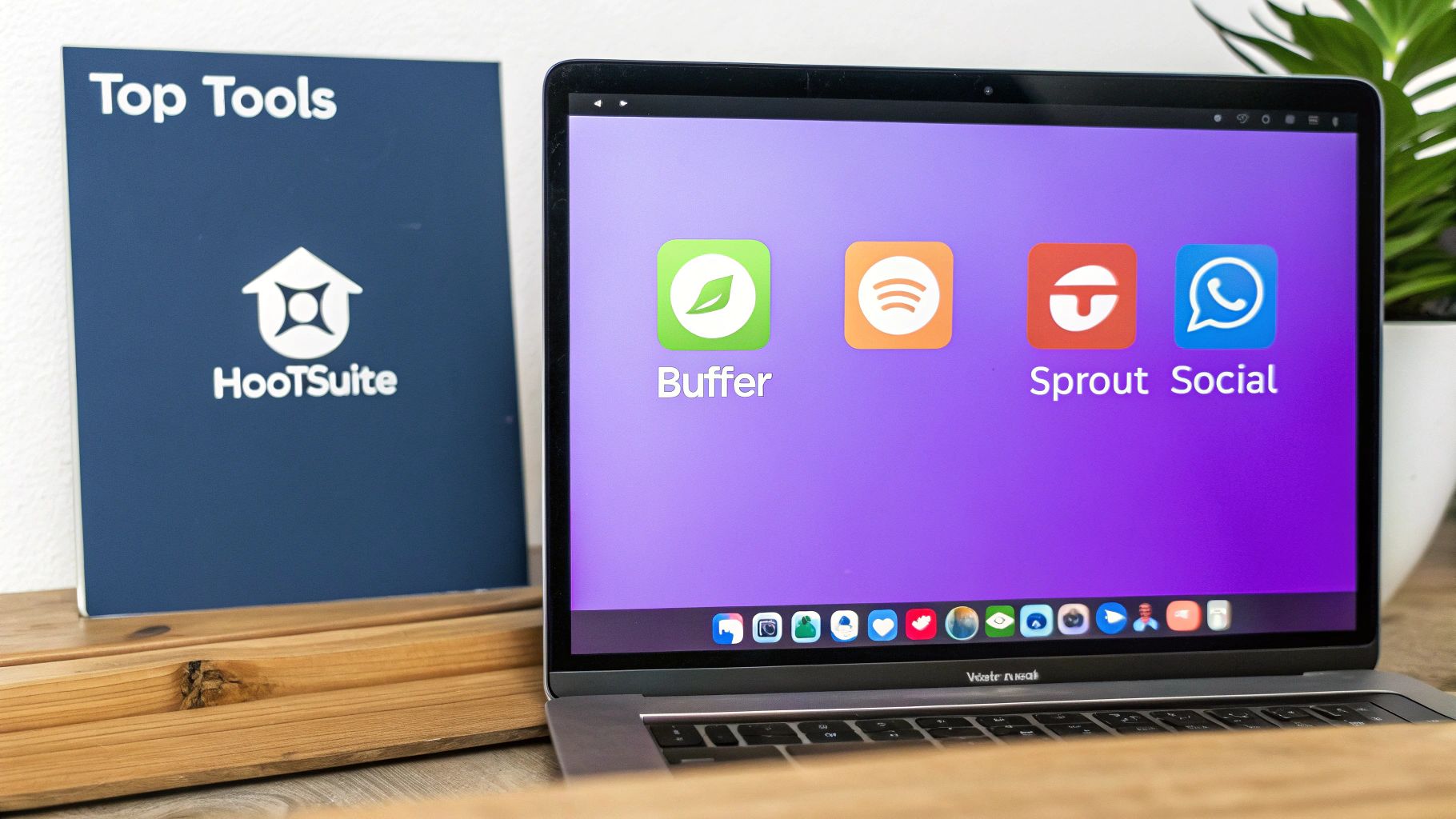
Okay, you've picked out your tools. Now it's time for the fun part: building the engine that will run your automated social media posting strategy. This is where you transform a bunch of cool features into a reliable, powerhouse system.
A solid workflow is what separates consistent, strategic content from the frantic, last-minute posts that do more harm than good. Forget guesswork. You need a system built on clear content pillars—the core themes that define your brand and guide every piece of content you create.
For a small business, this might be pretty straightforward, maybe focusing on educational tips and product spotlights. A larger brand will likely need more complex pillars, such as company culture, breaking industry news, or even user-generated content campaigns.
The point isn't to be restrictive, but to create a structure that makes your content creation process predictable and repeatable. This framework ensures every post, whether it was planned weeks ago or created on the fly, feels perfectly on-brand.
Building Your Content Buckets
A super practical way to bring those pillars to life is with content buckets. Think of these as different categories you can fill with post ideas. They help you maintain a healthy mix of content so your feed doesn't become a one-note sales pitch that sends followers running.
A balanced set of buckets might look something like this:
- Educational Posts: Share quick tips, how-to guides, and industry insights that actually solve your audience’s problems.
- Promotional Content: Announce new products, share special deals, and highlight customer wins or glowing testimonials.
- Behind-the-Scenes: Give people a peek at your team, your process, or a "day in the life" to build a genuine human connection.
- Community Engagement: Kickstart conversations by asking questions, running polls, or sharing user-generated content.
By sorting your ideas into these buckets, you build a diverse library you can pull from anytime. For a deeper dive on how to structure all this, our guide on building a social media content calendar has some great templates you can borrow.
Think of your workflow like a restaurant kitchen. Your content pillars are the menu sections (appetizers, mains, desserts), and the content buckets are the specific dishes. The schedule is your service plan, ensuring everything runs smoothly for your hungry patrons—your audience.
Establishing a Realistic Cadence
One of the biggest mistakes I see brands make is getting way too ambitious with their posting schedule. Sure, posting ten times a day sounds impressive, but it's a recipe for burnout and low-quality content. It’s a failed strategy if you can't keep it up past the first two weeks.
Your posting cadence needs to be sustainable for your team and match how your audience actually uses social media.
Start with a schedule you know you can stick to. It's far better to post one piece of high-quality, engaging content every day than to spam your followers with five mediocre ones. Once you get your workflow humming, you can always ramp things up.
The Power of an Evergreen Queue
Finally, no automated workflow is complete without an evergreen content queue. This is your secret weapon: a dedicated stash of timeless, high-value posts that aren't tied to a specific date or event. Think of your best-performing blog posts, foundational tips, or killer case studies.
Your automation tools can pull from this queue automatically to fill any gaps in your content calendar. It’s the safety net that keeps your profiles active during busy spells and squeezes every drop of value from your best content. An evergreen queue guarantees consistency and keeps your brand visible, 24/7.
Using AI to Create and Optimize Your Content
Smart automation is about so much more than just hitting "schedule." It's about making every single piece of content you create work harder for you. This is where AI assistants and the built-in intelligence of modern platforms can turn your automated social media posting from a simple chore into a powerful optimization engine.
Instead of staring at a blank screen, you can use AI to brainstorm fresh ideas, write compelling captions, and even create unique variations of a single post for different platforms. The real trick is to treat AI like a creative partner, not just a content factory. You'll get far better results when you guide it with thoughtful, detailed prompts.
Crafting High-Quality AI Prompts
The quality of your AI-generated content is a direct reflection of the quality of your prompts. If you give it vague requests, you'll get generic, uninspired copy in return. To get on-brand results that actually sound like you, you need to be specific and provide plenty of context.
For example, don't just say, "Write a tweet about our new product." That's a recipe for bland content.
Instead, try something like this:
"Write three engaging and witty tweets announcing our new 'Sunrise' coffee blend. Our brand voice is friendly and energetic. Mention that it has notes of citrus and chocolate, and it's perfect for starting the day. Include a call to action to shop now and use the hashtag #SunriseBrew."
See the difference? That level of detail guides the AI to produce content that genuinely reflects your brand. You can also ask for different tones—professional for LinkedIn, conversational for Instagram—to quickly tailor your message without starting from scratch. For more advanced ideas, check out these AI-powered content repurposing strategies to get more mileage from your core content.
Leveraging Built-In Intelligence
Many of the best automation tools come packed with their own smart features that go way beyond simple text generation. These data-driven suggestions are designed to maximize your impact with minimal effort on your part.
Here are a few key features to look for and use strategically:
- Best Time to Post: These tools analyze your account's past performance to pinpoint the exact moments your specific audience is most active and likely to engage. It completely removes the guesswork.
- Hashtag Generators: Instead of spending time manually researching hashtags, these tools suggest relevant and trending options based on your post's content and your industry. This is a simple way to help your content reach a much wider audience.
- Simple A/B Testing: Some platforms let you test different captions or images for the same post. They'll automatically analyze which version performs better, giving you invaluable insights for future content.
As AI-generated content becomes the norm, simply posting isn't enough to capture your audience's attention. Brands that lean on automated, data-driven strategies for both posting and interaction are the ones that will come out ahead. This approach helps you make smart decisions based on real data, rather than just chasing posting volume. You can find more data-driven insights about current social media trends on Sprout Social.
By combining your own creativity with these intelligent tools, you build a system that not only saves you time but also continuously learns and improves.
Measuring Your Success and Refining Your Strategy
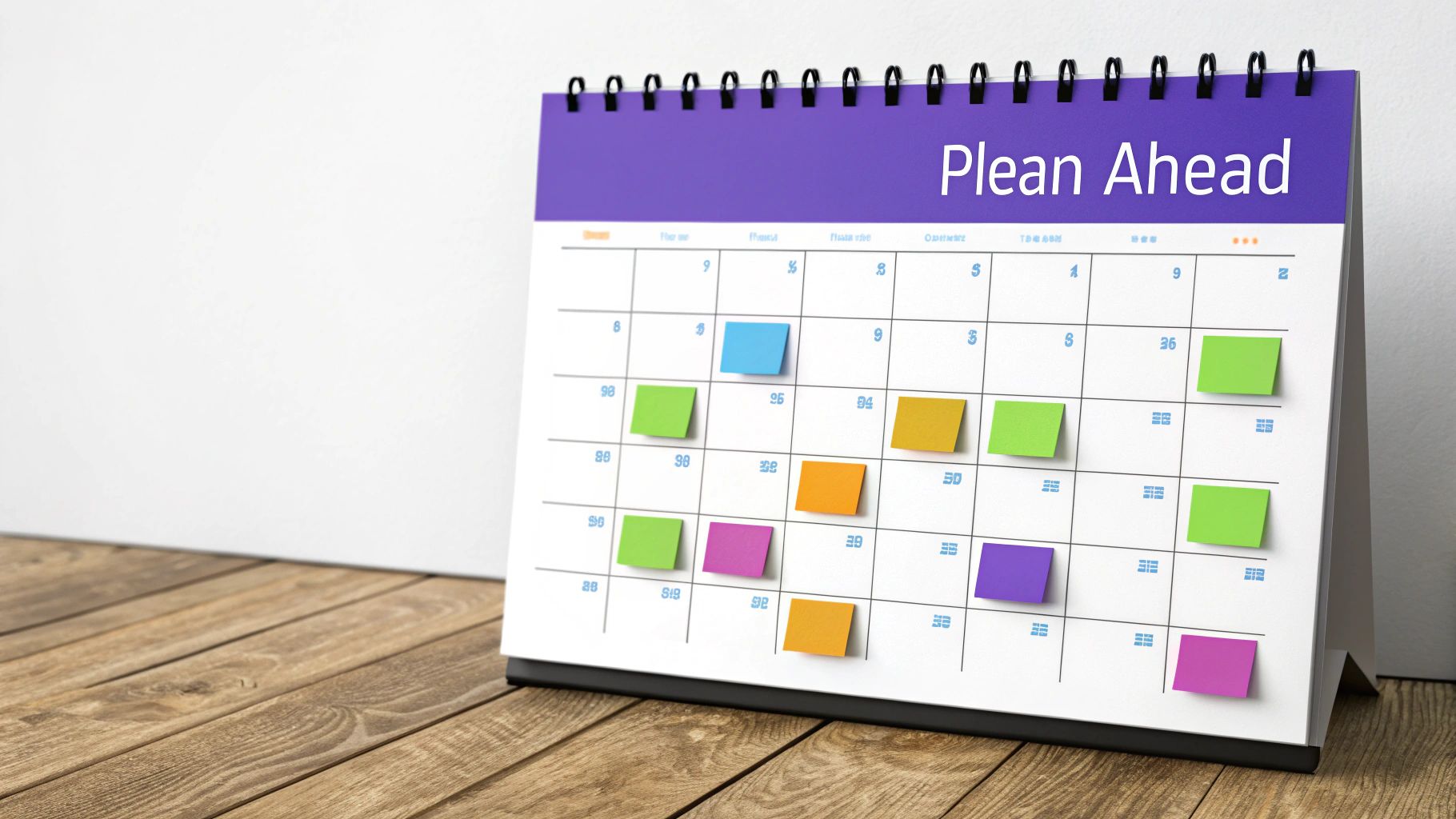
Alright, you've got your automation engine up and running. That’s a huge win, but don't pop the champagne just yet. The biggest mistake I see people make is treating automation as a "set it and forget it" tool. That's a surefire way to watch your results plateau and eventually fade away.
Real success comes from closing the loop—using data to see what’s working, what’s not, and making smart adjustments. It's time to move past the feel-good vanity metrics like raw follower counts or likes. They might boost your ego, but they don't pay the bills or tell you if your content is actually driving business. The real gold is in the data that shows genuine audience interest and action.
Focusing on Metrics That Matter
To get a clear picture of what's resonating, you need to dig into the data that reflects how your audience actually behaves. Think of your automation tool’s analytics dashboard as your mission control—it's where you'll find all the juicy insights.
Here are the key metrics I always keep an eye on:
- Engagement Rate: This is the percentage of your audience that actually interacts with your posts. It’s a far better indicator of content quality than just counting likes, as it shows you what genuinely captures attention.
- Click-Through Rate (CTR): This tells you how many people clicked a link in your post. CTR is your direct line to measuring how well your content drives traffic to your website, blog, or landing pages.
- Conversions: This is the ultimate goal. You need to track how many of those clicks from social media lead to a meaningful action, whether that's a newsletter sign-up, a lead-gen download, or an actual purchase.
The power of smart automation really shines on professional networks. For instance, LinkedIn posts can average over 600 engagements for mid-sized accounts. We've also seen that using AI for automated messaging can boost recruitment acceptance rates by a staggering 44%. This proves that good automation doesn't just increase reach; it improves the quality of your interactions.
Your analytics dashboard isn't just a report card; it's a treasure map. It shows you exactly where to dig to find your best-performing content, the optimal posting times for your audience, and which platforms deliver the highest return.
Turning Data Into Actionable Insights
Once you've got your hands on the right data, the real work begins: turning those numbers into smarter decisions. This is an ongoing cycle of testing, learning, and refining your approach. For a more complete look at this process, our guide on how to measure social media success offers a great framework.
Don't just stare at the numbers—ask what they're trying to tell you. Did a post asking a question get an unusually high engagement rate? That's a clear signal to create more conversational content. Is your CTR on X (formerly Twitter) consistently crushing your Facebook numbers? Maybe it's time to focus more of your energy there.
To truly understand if your automated strategy is paying off, you need to know how to calculate the ROI of your automation efforts. This connects the time and money you're investing directly to tangible business outcomes, proving the value of what you're doing. By constantly analyzing your performance and tweaking your strategy, you transform your automation system from a simple scheduler into a powerful feedback loop that drives sustainable growth.
Common Questions About Social Media Automation
Diving into social media automation for the first time? You probably have a few questions. It's totally normal to worry if your brand’s personality will get lost in the shuffle or if the cost is even worth it. Let's get into some of the most common concerns we hear from founders and marketers.
The biggest fear is almost always the same: sounding like a robot. It’s a valid worry, but thankfully, one that’s easy to avoid. Just remember, automation is a tool for distribution, not a substitute for your voice and strategy.
You're still the one in the driver's seat. By creating your content in focused batches, you can make sure every single post sounds like you. A great approach is to mix your scheduled evergreen content with spontaneous, in-the-moment engagement. That blend keeps the crucial human touch alive and well.
Will It Cost Too Much for a Small Business?
The second question that always comes up is about the price tag. With so many sophisticated platforms out there, it's easy to think effective automation is only for big corporations with money to burn. That couldn't be further from the truth. The market is packed with powerful tools for every budget.
Many of the top social media automation tools offer plans that scale right alongside your business. You can kick things off with a basic, affordable plan for scheduling and simple analytics. As your strategy gets more complex, you can upgrade to unlock features like deep-dive reporting or team collaboration.
The real key is to see the cost as an investment, not an expense. When you add up the hours you'll save and factor in the potential for more engagement and leads, the ROI usually becomes obvious pretty quickly.
Can Automation Hurt My Engagement?
There's a persistent myth that social media algorithms penalize posts coming from third-party tools. This idea is largely a relic of the past. Today, major platforms like Instagram and LinkedIn have official API partnerships with the big automation tools, which means they're designed to play nicely together.
Engagement isn't about how you post; it's about what you post. If you’re sharing valuable, relevant, and interesting content, your audience will respond. In fact, automation can actually boost engagement by making sure you’re consistently posting when your followers are most active.
Here’s how to think about it:
- Consistency builds trust. When your audience knows they can expect great content from you, you stay top-of-mind.
- Quality over quantity. By freeing up time you’d otherwise spend on manual posting, you can pour that energy into creating higher-quality content that truly connects.
At the end of the day, automation is a powerful ally that helps you connect better, not a shortcut that forces you to sacrifice authenticity.
Ready to build a powerful, authentic presence without the manual grind? MakerBox uses AI to generate on-brand content, optimized bios, and stunning profile images in seconds. Transform your profiles and start seeing real results today. Explore MakerBox and start your 14-day trial.


